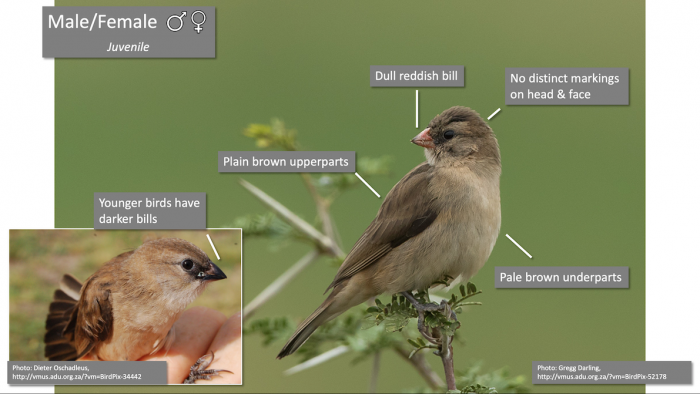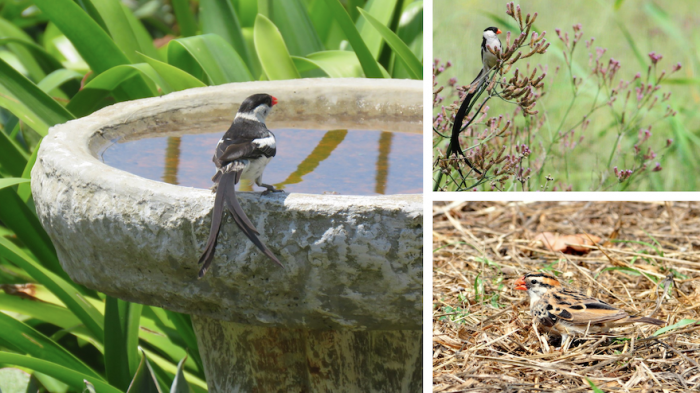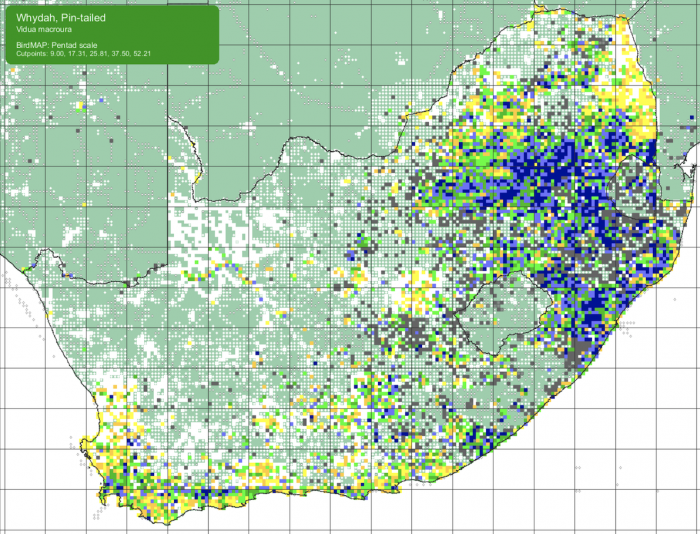Identification
The Pin-tailed Whydah is a small sexually dimorphic species. Males and females differ dramatically when breeding, and appear similar outside of the breeding season. These seasonal “wardrobe changes” are common in many bird species in which one sex (usually the male) performs a display or builds a special structure to attract a mate. Pin-tailed Whydahs fall into the first category; males sing and perform elaborate aerial displays to attract the attention of females.
As environmental conditions become suitable for raising young, males undergo a process called moult, replacing their drab everyday feathers with striking, boldly-coloured breeding plumage. For species like the Pin-tailed Whydah that undergo these seasonal transformations, we can divide identification into a few different categories: breeding male and female, non-breeding male and female, and juvenile.
Let’s start with the breeding male. In full breeding plumage, the male Pin-tailed Whydah is difficult to miss. He is white with a black cap on his head, a bright reddish-orange bill, black legs, and a distinct long, flowing black tail.

By contrast, breeding females make a much less flashy counterpart. A key feature to look for in Whydahs is a striped head. The female Pin-tailed Whydah has a brownish head and face with bold black stripes. She is a pale buff or whitish colour underneath, has black legs, and her back is a mottled mix of brown and black. When breeding, her bill is usually black.

Though it might be hard to imagine, outside of breeding season, males and females look very much alike and can be difficult or impossible to tell apart! Overall, they more closely resemble a breeding female. The head and face are brownish with bold black stripes, the underparts are a pale buff colour, and the back is mottled brown and black. The bill is always red in males, but non-breeding females may have a red or blackish-red bill, making it hard to know for certain which is which.

This becomes a bit easier to untangle when males begin moult; let’s have a look at a male in transitional plumage. This bird is in the process of changing its non-breeding feathers to its bold black-and-white breeding colours. If you see a group of Pin-tailed Whydahs, keep an eye out for males in various stages of transition. You might notice black feathers starting to grow on the back and wings, the beginnings of a black cap on the head, or, often most conspicuously, a half-grown black tail.

What about birds that are too young to breed? The juvenile Pin-tailed Whydah looks quite different to adult birds; it can be tempting to see a juvenile and think it is a different species! There are no distinct stripes on the head and face, and the entire body is a plain brownish colour. The bill is usually a dull pinkish-red, but very young birds have blackish bills.

Inset photo: Dieter Oschadleus, Cape Town, Western Cape. 4 February 2017. BirdPix 34442
Pin-tailed Whydahs are noisy and communicative, especially breeding males. Their high-pitched, squeaky song is a common sound in gardens.
Habitat
The Pin-tailed Whydah feeds on grass seeds, often on bare ground. If you watch a Pin-tailed Whydah foraging, you might observe an interesting behaviour; they often use their feet to kick soil away and reveal seeds. This species is at home in a range of habitat types, including savanna, grassland, dense vegetation along running water, wetlands, edges of agricultural fields and residential gardens.

In gardens, Whydahs are frequent visitors to bird feeders, and breeding males are notorious for their tendency to aggressively “defend” feeders from other birds. If you have Whydahs feeding in your garden, keep an eye out–territorial interactions between male Whydahs and other species are almost inevitable!
Distribution
In southern Africa, the Pin-tailed Whydah is common within the Western Cape and along the eastern coast of South Africa, as well as in Zimbabwe and Mozambique and parts of Namibia and Botswana. In years with good rainfall, they may also be found in the typically drier inland regions of Namibia and South Africa.

Pin-tailed Whydahs are not confined to southern Africa; they are widespread in continental Africa and a common sight in many countries south of the Sahara desert. They are also an introduced species in the United States, Singapore, and Puerto Rico.

Behaviour
Pin-tailed Whydahs are gregarious birds. When breeding, they tend to form small groups composed of a single breeding male and a mix of several females and non-breeding males. Outside of the breeding season, these groups may be much larger, expanding to include 30 or more individuals.
Breeding males have a knack for making themselves seen through a combination of aggressive behaviour, continuous vocalization, and eye-catching flight displays. You can watch a male singing and displaying in this video, created by Lynette Rudman.
When it comes to raising young, Pin-tailed Whydahs are masters of finding shortcuts! These birds are brood parasites; birds that lay their eggs in the nest of another species. A male Pin-tailed Whydah will aggressively defend a small territory in the breeding season, chasing off other birds and singing from conspicuous perches. Females will visit the territories of males who offer impressive songs and displays, and will often mate with more than one male.

After mating, the female searches for a suitable host nest in which to lay her eggs, and on finding a nest, may remove or even eat one of the host bird’s eggs before laying her own! The host, usually a Common Waxbill, is then left to feed and raise a Pin-tailed Whydah alongside its own young. Common Waxbill and Pin-tailed Whydah hatchlings look remarkably similar, and newly-hatched Whydahs will even mimic the begging behaviours of young Waxbills. Waxbill parents will feed both their own young and the Whydah until the chicks are ready to leave the nest; at this point, the Whydah chick leaves the Waxbills and re-joins a flock of Pin-tailed Whydahs.
This flashy parasite can be seen in action in the BBC documentary series “Attenborough’s Life in Colour.” Check out Series 1, episode 2: Hiding in Colour.
Further resources
Species text in the first bird atlas (1997)
Virtual Museum (BirdPix > Search VM > By Scientific or Common Name)
More common names: Koningrooibekkie (Afrikaans); Veuve dominicaine (French); Dominikanerwitwe (German); Vedova coda a spilli (Italian); Viuda colicinta (Spanish)
List of bird species in this format is available here.
Recommended citation format: Daniel KA 2021. Pin-tailed Whydah Vidua macroura. Biodiversity and Development Institute. Available online at https://thebdi.org/2021/10/29/pin-tailed-whydah-vidua-macroura/

